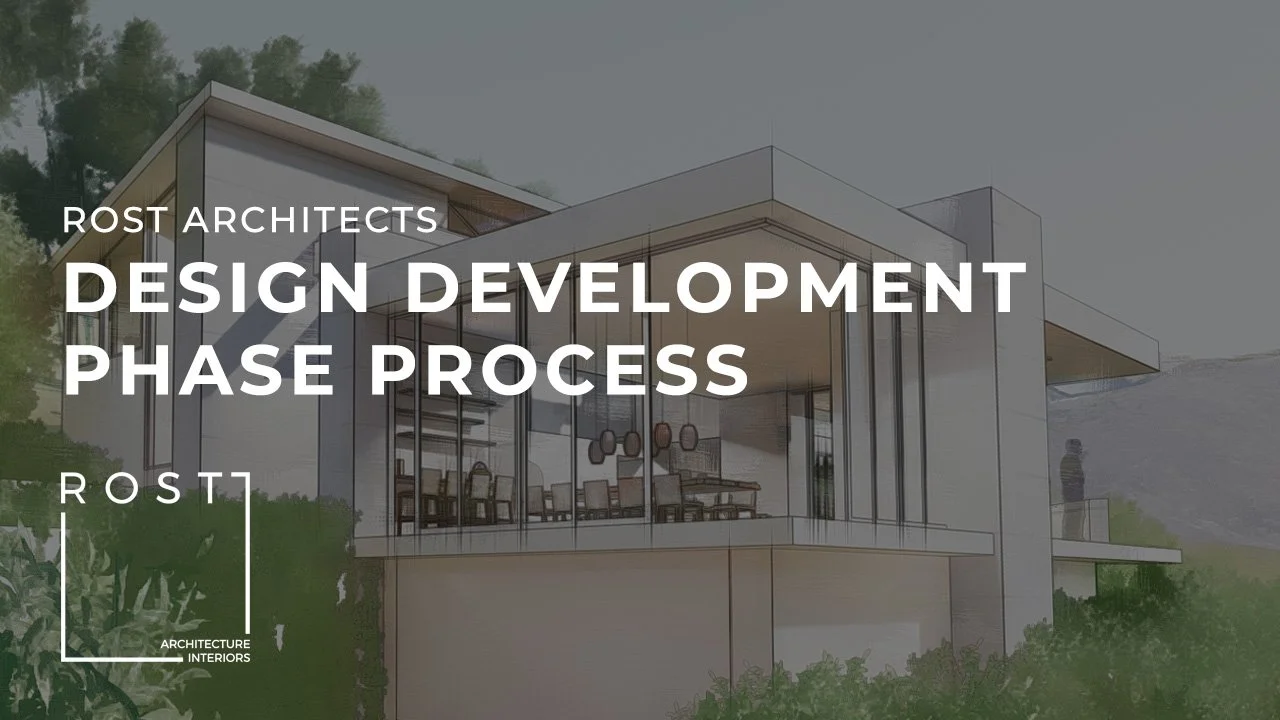Rost Architects Construction Documentation Process
Rost Architects Construction Documentation Process
PROJECT PHASES
Construction Administration
Construction Documentation Phase
The Construction Documentation phase of the project is customarily the third phase in a typical project. The “CD” or Construction Documentation phase is exactly what it says, the Architectural team will be producing the documents that will be used during construction to build the home. (To learn more about the preceding phases, Schematic Design and Design Development, click on the respective links.)
In this phase our team will be taking the approved design and documenting it in technical drawings. This set of documents will be processed through the city/county to secure permits. The General Contractor will use this set of technical drawings to build the home. The more time we can invest in the drawings, the more thorough the documentation will be. This often results in a smoother construction process and more accurate pricing from the Contractor building the home.
In contrast, a poor set of construction documents that only provides the minimum documents required to secure permits will often leave many items open for the contractor to interpret. In this scenario, the contractor may be forced to fill in holes in the drawings with assumptions. These assumptions may or may not be in alignment with the quality and design that the owner and architect are expecting. For this reason, we advocate for allowing our team enough time in the project schedule to put together a thorough set of drawings leaving little room for interpretation.
The Construction Document set typically contains the following set of Architectural drawings:
Material Specifications
Specifications for all Architectural Exterior/Building material as well as all interior finish materials.
Equipment and Fixture Schedule
Specifications for all plumbing fixtures, appliances, accessories, and mechanical fixtures.
Construction Assemblies
Detailed drawings on all of the layers of materials required to construct the floors, walls and roofs. The construction assemblies will show items such as material thickness, waterproofing layers and insulation among others.
Site Plan
Plan of the entire property showing the location of the new home, property lines, setbacks, easements, pools, fences, hardscape and other site features.
Floor Plans
Dimensioned architectural floor plans showing the layout of the home, rooms, floor finishes, plumbing locations, door/window locations and the general layout of the home.
Roof Plans
The Roof Plans illustrate the elements that make up the roof of the home. This drawing shows ridges, valleys, and hips. It also may indicate the roofing material and slopes of roof surfaces, as well as chimneys, skylights, roof parapets, drain locations, solar panels and other architectural elements.
Elevations
The Elevations show each side of the house. They are dimensioned showing heights of the roof, ceilings, and other elements on the exterior of the home. These drawings show the door and window layout, exterior materials, and the different levels on the home.
Sections
The building sections show what the building would look like if you were to cut through the home. It shows the relationship the ground to the house and the roof. This drawing will show locations of major beams, floor structures, and the vertical heights of the building.
Ceiling Plans
This drawings shows the location of lighting fixtures, fans, switches and outlets. It shows the intent of the lighting design and any home automation control system. The ceiling plan will also show ceiling material finishes and heights.
Interior Elevations
The interior elevations show each interior wall of the home with the specific finishes, tile layout, fixtures, casework/cabinet details and design, and interior details. These drawings are critical when the contractor begins finishing out the interior of the home.
Details
The architectural details show key connections, transitions and major architectural features on the home. These details will show the contractor how we want these features to look and function.
Door Schedule
The door schedule itemizes each door in the project with its size, operation, frame material, and finish. The schedule also shows a recommended manufacturer and model.
Window Schedule
The window schedule itemizes each window in the project with its size, operation, frame material, and finish. The schedule also shows a recommended manufacturer and model.
Along with these basic drawings, the Architectural team is also responsible for coordinating, reviewing and collating all of the consultant drawings into the Construction Document set. To read more about the typical consultants drawings on a project, check out our article Project Team for Your Custom Home.
Plan Check and Permitting
Part of the Construction Document phase is assembling the construction set and submitting it to the city or county for permits. Understanding the drawing requirements of the city/county and the requested sequencing is critical to a smooth permitting process. Our team will work with the different agencies to ensure the drawings are submitted and routed to the appropriate parties for review and in the correct order.
The plan check process is structured in “rounds.” For example we will submit the drawings to each department. This will be the first round of plan check. Each department will review and provide comments on the drawings. Our team will take these back to the office, address and respond to the comments, then resubmit the plans. The resubmittal will be the second round of plan check. Typically there will be two or three rounds of plan check for a project. This process can be lengthy depending on the efficiency and staffing of the city/county. The cities usually have required timeframes in which they are obligated to return comments to the architect, unfortunately these are frequently not met. We do our best as a project team to push the city to review the plans however we are often at the mercy of their scheduling.
In a typical high end custom home project there is typically between 100-200 sheets in a Construction Document set depending on the project scale and scope. Each one of these drawings is meticulously prepared, thoroughly checked and coordinated by our team. The goal with the documents is to precisely define 100% of the home so that the contractor can accurately bid the project and there are no scope gaps. This is not to say the set will be completely free from errors/inconstancies or missing scope, however with each project we are aiming to prepare the best set of plans we can produce.
If you would like to learn more about our Construction Documentation process, contact us at www.rostarchitects.com/contact























